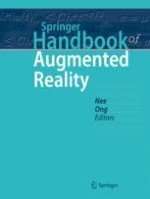2023 | OriginalPaper | Chapter
15. Potentiating Learning Through Augmented Reality and Serious Games
Authors : J. M. Cerqueira, B. Cleto, J. M. Moura, C. Sylla, L. Ferreira
Published in: Springer Handbook of Augmented Reality
Publisher: Springer International Publishing
Activate our intelligent search to find suitable subject content or patents.
Select sections of text to find matching patents with Artificial Intelligence. powered by
Select sections of text to find additional relevant content using AI-assisted search. powered by
